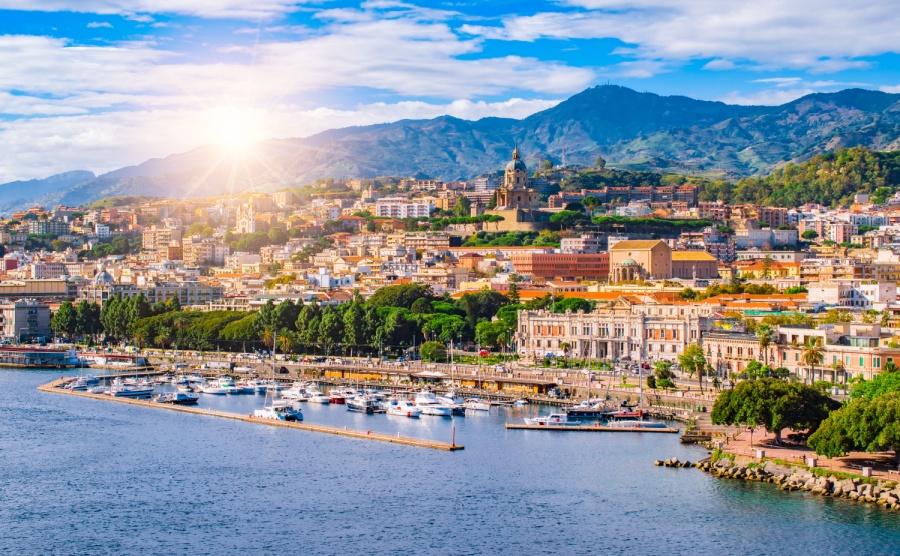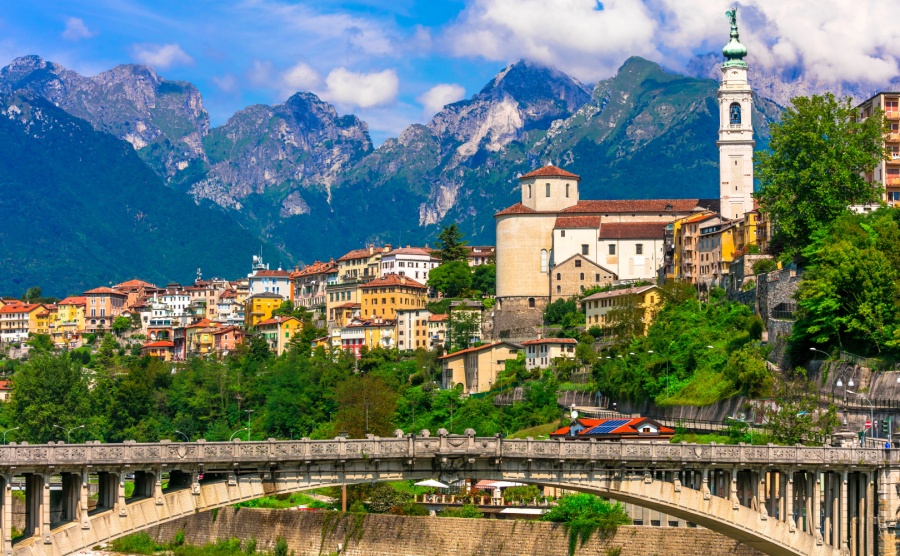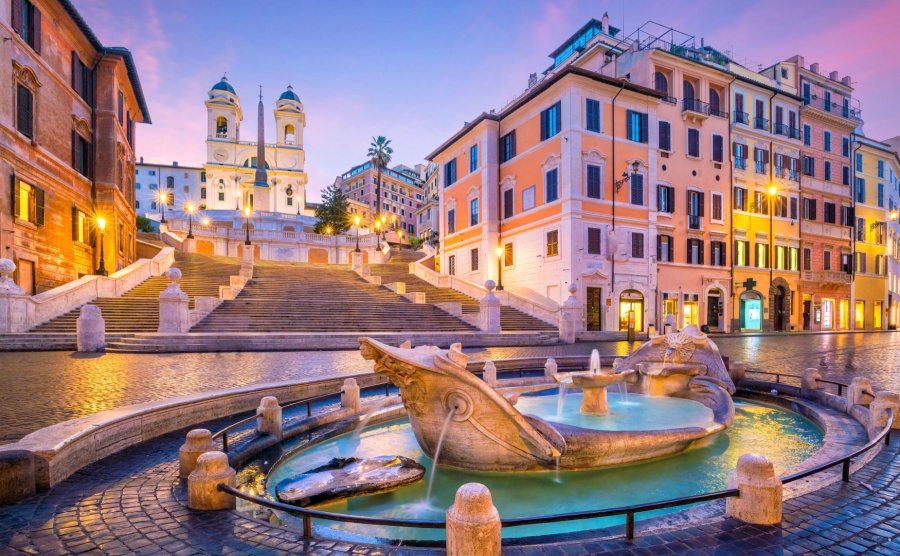Do you like four seasons, with proper snow in the winter, or somewhere that’s warm all year? Are you only happy if the sun is cracking the pavement, or a bit nervous about heatwaves? Is a sea breeze on your essentials list and is frost a total no-no?
In Italy the weather varies from north to south, mountain to coast, and summer to winter.
So, when looking for where to buy a property it’s worth considering the climate. Where in Italy has the weather that will suit you best?
There’s more than just sunshine hours and rainfall to consider when looking for the perfect place to buy a property. Some locations may get uncomfortably hot in summer, others may be prone to extreme weather conditions.

Sunrise over Sicily
In Italy, the beautiful and varied landscape is a product of the changing seasons and weather. From the snow-capped mountains to the spring flowers on the plains, the climate plays an important role. Therefore, the best location could be somewhere that has the least extremes of weather.
Weather criteria
Each year Il Sole 24 Ore produces a ranking of the best climate locations in Italy. How are they defining “best”? Gathered over the past decade, the data considers sunshine hours, heat, heatwaves, extreme events, summer breeze, relative humidity, gusts of wind, rain, fog and the number of cold days.
Sunshine isn’t everything
While the top three places for hours of sunshine per day went to Agrigento, Syracuse and Crotone, they didn’t come top of the overall rankings.
For example, despite Syracuse, the gorgeous Baroque city, in Sicily having long sunshine hours and a low number of cold days, it’s prone to heatwaves. In the summer of 2023, Syracuse reached an all-time high of 47°C. It also has the highest heat index: 111 days a year with a perceived temperature above 35°C. Therefore, Syracuse came 54th overall in the ranking.
Rainy weather
Most of us aren’t happy when it rains, but a certain amount is important to keep the countryside green, water the crops and replenish wells. Too much rain can cause flooding and landslides, too little and you get wild fires. Therefore the “Best Climate Ranking” rewarded the locations that on average had few rainy days per year, but also penalised the driest places.

Belluno, in the Dolomites
Although Belluno in the Dolomites is a beautiful town where you can breath the fresh mountain air, it averages 118 rainy days each year and just 6.7 hours of sunshine per day. But if you enjoy walking in green surroundings with a view of the Dolomites, or skiing down snowy mountains, this could still be the place for you.
Coastal areas
Coastal areas tend to have milder climates than inland. The sea has a moderating effect on temperature as water heats up and cool down more slowly than land. As a result, coastal areas tend to have milder, more stable temperatures with less extreme seasonal variations.
In Italy, the land can be quite flat near the coast for quite a distance before reaching hills and mountains. Often rain clouds will blow straight over, until they reach higher ground.
Among the Italian provinces with the best climate many are on the coast. In order of ranking, according to Il Sole 24 Ore, they are:
- Bari in Puglia
- Imperia in Liguria
- Barletta-Andria-Trani in Puglia
- Catania on Sicily
- Pescara, Abruzzo
- Livorno, Tuscany
- Chieti, Abruzzo
- Brindisi, Puglia
- Agrigento, Sicily
- Cagliari, Sardinia
- Enna, Sicily
- Ancona, Marche
- Crotone, Calabria
- Catanzaro, Calabria
- Rimini, Emilia-Romagna
Higher ground
Some high-altitude locations, such as Aosta at 583 metres and Enna at 931 metres, offer a comfortable climate thanks to good air circulation. Typically, you will experience cooler temperatures the higher you go. Therefore, in a region that has hot summer temperatures, you may prefer a hill town location, especially if the position of your windows allow a nice through breeze.
Some properties may also have a room partly built into the rock. These are a wonderful cool place to retreat to on a hot afternoon.
Climate in the Po River Valley
The Po plain, stretching across northern Italy, is used for intensive agriculture and half of the river length is controlled by dikes to minimize flooding. The Po Valley generally has a humid subtropical climate, getting increasingly warmer and more humid the further you go east and south.
However, the area does frequently get fog and mist, and winters tend to be cool and damp. Thunderstorms, hail storms and tornadoes can also occur. However, for a summer holiday home location its temperatures are a comfortable 25C.
The last ten places of the climate rankings include various places in the Po Valley area. These include Alessandria (106th), Pavia (105th), Cremona (104th), Piacenza (102nd), Lodi ( 101st), Asti (100th) and Ferrara (99th). In particular, Rovigo has the most fog, with over 57 days per year. However, it is Verbania that came last with a high frequency of heavy rainfall.
Hot Italian cities
Temperatures in large cities have risen in the last 30 years. Those Italians who live in Italian cities and can afford to travel, head to the coast or countryside during the hottest days of summer.
Around Ferragosta, many businesses close completely for a summer break. Ferragosta is a public holiday celebrated on the 15th August, throughout Italy. It originates from Feriae Augusti, the festival of Emperor Augustus, introduced in 18BCE.
City heat
City buildings absorb heat and act like radiators warming the city air. With so many buildings, airflow is also reduced. Therefore, Italian cities do their best to create shade with avenues of trees, porticoes and parks. Trees are the most effective, as not only does the canopy create shade, evaporation also cools the air. But, in July and August it can get very hot, therefore city residents will try and escape to the coast.
Cities by the sea
In Rome’s case, the Tyrrhenian Sea (Mare Tirreno) is only about 25km from the city. You can catch a train to some lovely beaches. Such as Ostia or Sperlonga. Naples, Venice, and Genoa are right on the sea. Therefore, you can stroll along the waterfront to catch the sea breeze, or take a short trip along the coast to some beautiful beaches.

Rome at dawn, while it’s cool
City rankings
Among the large cities in the climate rankings, Cagliari took 10th place, Rome came in 25th place, followed by Naples (26th), Venice (32nd) and Genoa (43rd). All the others, however, are in the second half of the ranking, with Milan in 86th place. Milan’s location creates a warm temperate climate with hot summers. Temperatures in August have an average high of 28.5 C and in January 5.9C. On the down side it can get hot and muggy and the area is prone to fog, especially over the winter months.
Florence
Although Florence has hot summers, its cold, wet winters lowered its ranking to 65th. The average summer temperatures are a lovely 32C, but in December and January they drop to an average of 11C. If you want to visit Florence in the spring, March or the end of May tend to be best. April has the most spring rain and November is the wettest month.
Find homes in Italy via our property portal.
Top 5 for Climate
The latest rankings uses data from 2013-2023 and lists the name of the main city in each province. Here are the top 5 provinces considered to have the best climate.
1. Bari, Puglia
In first place, with what is considered the most comfortable climate, is Bari in the Puglia region of southern Italy. The province has long hot summers with a high number of sunny days throughout the year. On average there are 8.5 hours of sunshine a day and only nine days of heavy rain per year.
Being located on the Adriatic coast the towns nearest the sea get a pleasant summer breeze and a comfortable climate. Bari province includes several towns popular with tourists and property buyers. They include Alberobello, Castellana Grotte, Locorotondo, Monopoli, Noci, and Polignano a Mare.
2. Imperia, Liguria
Despite being in the northwest of the country, Imperia has something of a micro climate along the coast. This is partly due to being sheltered by the mountains behind. Although it does rain, they don’t tend to get extreme weather. In the Victorian era the area was popular with the British, with even Queen Victoria herself being a fan.
The province of Imperia includes well known town of Sanremo. The weather is so peasant here that between Sanremo and Albenga, there is a big flower-growing area, hence being labelled the “riviera dei fiori”. Although, in winter there is a noticeable difference between temperatures in seaside resorts and inland.
3. Barletta-Andria-Trani, Puglia
The climate is typically Mediterranean, with hot, dry summers, and rain in winter. It mainly rains on higher ground and you can get snow on the mountains. In summer it can feel a little muggy, but temperatures are typically above 30C.
The province of Barletta-Andria-Trani is located in central-northern Puglia. It borders the provinces of Foggia, Bari, and Potenza ( Basilicata ), and the Adriatic sea. Unusually, the title of capital is shared between the three towns. Andria is inland and has the largest population of over 96,000. While Barletta and Trani are more popular, because of their seaside locations.
4. Catania, Sicily
The plain of Catania has a Mediterranean climate. Winters are mild, but cooler at night. The mighty Mount Etna shelters the city from any northerly winds. Summers are long, with high humidity. Although along the coast it is fresher due to sea breezes. In June, July and August temperatures are generally in their 30s. In recent years they have been getting higher, even into the 40s.
The province of Catania is located on the eastern coast of Sicily. The city is spread over the southern slopes of Etna and has beautiful squares, baroque buildings and a city beach. Indeed, there are many great beaches in the area. Others lovely towns and villages include: Acicastello, Aci Trezzo, Vizzini and Acireale. Then there is Militello which has a historic centre recognised by Unesco.
5. Pescara, Abruzzo
The city of Pescara is located in the Abruzzo region on the Adriatic coast. The climate is almost mediterranean. Summers are hot and sunny, around 24C in July and August, with a high of 30C. Although it has been known to reach a lot higher.
Winters are cold, due largely to winds blowing over from Eastern Europe. January and February are the coldest months with average temperatures between 7C and 8C. Most rain is between October and March, with November having the most (80mm). Winter weather varies one day to the next. If the Garbino wind blows from the south west it can get quite warm, even in January.
Pescara is the largest city in Abruzzo, and has one of the biggest marinas in the Adriatic. It has a lively seafront in summer and 16km of sandy beaches. With the Abruzzo mountains on one side and the Adriatic sea on the other, Pescara combines, nature, history and relaxation. The whole region is known for it’s natural beauty, with lush green hills, mountains and sandy beaches.
Other good weather locations
Following the top 5 in the “Best climate rankings” are, 6. Livorno, Tuscany, 7. Chieti, Abruzzo, 8. Brindisi, Puglia, 9. Agrigento, Sicily, and 10. Cagliari, Sardinia. To see the full list visit 24sole24ore Climate Index.











